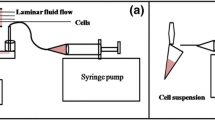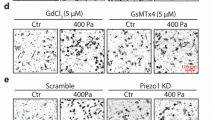Abstract
Introduction
Cells in the tumor microenvironment experience mechanical stresses, such as compression generated by uncontrolled cell growth within a tissue, increased substrate stiffness due to tumor cell extracellular matrix (ECM) remodeling, and leaky angiogenic vessels which involve low fluid shear stress. With our hypothesis that shear stress increases V–H\(^+\)-ATPase number density in prostate cancer cells via activation of the mTORC1 and mTORC2 pathways, we demonstrated and quantified such a mechanism in prostate cancer cells.
Methods
Moderately metastatic DU145 and highly metastatic PC3 prostate cancer cells were subjected to 0.05 dynes \(\hbox {cm}^{-2}\) wall shear stress for 24 h, followed by immunocytochemistry and fluorescence measurements of \(\beta\)1 integrin, endosome, lysosome, V–H\(^{+}\)-ATPase proton pump, mTORC1, and p-mTORC2 antibodies. Post shear stress migration assays, and the effects of vacuolar proton pump inhibitor Bafilomycin A1 (60 nM, 24 h) as well as shear stress on the ICC fluorescence intensity of the proteins of interest were conducted with DU145 cells.
Results
Low fluid shear stress increases the fluorescence intensity of \(\beta\)1 integrin, endosome, lysosome, V–H\(^{+}\)-ATPase, mTORC1, and p-mTORC2 antibodies in PC3 and DU145 cells, and also increased cell migration. However, Bafilomycin A1 decreased fluorescence intensity of all of these proteins in DU145 cells exposed to shear stress, revealing that V–H\(^+\)-ATPase controls the expression of these proteins.
Conclusions
Prostate cancer cell mechanotransduction increases endosomes, lysosomes, and proton pumps—where increases have been associated with enhanced cancer aggressiveness. We also show that the prostate cancer cell’s response to force promotes the cancer drivers mTORC1 and mTORC2.










Similar content being viewed by others
Data Availability Statement
The datasets generated during and/or analyzed during the current study are available from the corresponding author on reasonable request.
References
Betapudi, V., L. S. Licate, and T. T. Egelhoff. Distinct roles of nonmuscle myosin II isoforms in the regulation of MDA-MB-231 breast cancer cell spreading and migration. Cancer Res. 66:4725–4733, 2006.
Burgess, A., S. Vigneron, E. Brioudes, J.-C. Labbé, T. Lorca, and A. Castro. Loss of human greatwall results in g2 arrest and multiple mitotic defects due to deregulation of the cyclin b-cdc2/pp2a balance. Proc. Natl. Acad. Sci. USA 107(28):12564–12569, 2010.
Cotter, K., L. Stransky, C. McGuire, and M. Forgac. Recent insights into the structure, regulation, and function of the V-ATPases. Trends Biochem. Sci. 40:611–622, 2015.
Davidson, S. M. and M. G. Vander-Heiden. Critical functions of the lysosome in cancer biology. Annu. Rev. Pharmacol. Toxicol. 57:481-507, 2017.
Dielschneider, R. F., E. S. Henson, and S. B. Gibson. Lysosomes as oxidative targets for cancer therapy. Oxid. Med. Cell. Longev. 2017:3749157, 2017.
Dozynkiewicz, M. A., N. B. Jamieson, I. MacPherson, J. Grindlay, P. V. van den Berghe, A. von Thun, J. P. Morton, C. Gourley, P. Timpson, C. Nixon, et al. Rab25 and CLIC3 collaborate to promote integrin recycling from late endosomes/lysosomes and drive cancer progression. Dev. Cell 22:131–145, 2012.
Esen, E., J. Chen, C. M. Karner, A. L. Okunade, B. W. Patterson, and F. Long. WNT-LRP5 signaling induces Warburg effect through mTORC2 activation during osteoblast differentiation. Cell Metab. 17:745–755, 2013.
Fennelly, C. and R. K. Amaravadi. Lysosomal biology in cancer. Lysosomes Methods Protoc. 1594:293–308, 2017.
Gomez, G. A., R. W. McLachlan, and A. S. Yap. Productive tension: force-sensing and homeostasis of cell-cell junctions. Trends Cell Biol. 21:499–505, 2011.
Guertin, D. A. and D. M. Sabatini. Defining the role of mTOR in cancer. Cancer Cell 12:9–22, 2007.
Gulhati, P., K. A. Bowen, J. Liu, P. D. Stevens, P. G. Rychahou, M. Chen, E. Y. Lee, H. L. Weiss, K. L. O’Connor, T. Gao, et al. mTORC1 and mTORC2 regulate EMT, motility and metastasis of colorectal cancer via RhoA and Rac1 signaling pathways. Cancer Res. 71(9):3246–3256, 2011.
Hämälistö, S. and M. Jäättelä. Lysosomes in cancer–living on the edge (of the cell). Curr. Opin. Cell Biol. 39:69–76, 2016.
Icard-Arcizet, D., O. Cardoso, A. Richert, and S. Hénon. Cell stiffening in response to external stress is correlated to actin recruitment. Biophys. J. 94:2906–2913, 2008.
Jalali, S., M. A. del Pozo, K.-D. Chen, H. Miao, Y.-S. Li, M. A. Schwartz, J. Y.-J. Shyy, and S. Chien. Integrin-mediated mechanotransduction requires its dynamic interaction with specific extracellular matrix (ECM) ligands. Proc. Natl. Acad. Sci. 98(3):1042–1046, 2001.
Jilkova, Z. M., J. Lisowska, S. Manet, C. Verdier, V. Deplano, C. Geindreau, E. Faurobert, C. Albigès-Rizo, and A. Duperray. CCM proteins control endothelial \(\beta\)1 integrin dependent response to shear stress. Biol. Open 3(12):1228–1235, 2014.
Kim, K. M., Y. J. Choi, J.-H. Hwang, A. R. Kim, H. J. Cho, E. S. Hwang, J. Y. Park, S.-H. Lee, and J.-H. Hong. Shear stress induced by an interstitial level of slow flow increases the osteogenic differentiation of mesenchymal stem cells through TAZ activation. PLoS ONE 9(3):e92427, 2014.
Laplante, M. and D. M. Sabatini. mTOR signaling in growth control and disease. Cell 149:274–293, 2012.
Lee, H. J., M. F. Diaz, K. M. Price, J. A. Ozuna, S. Zhang, E. M. Sevick-Muraca, J. P. Hagan, and P. L. Wenzel. Fluid shear stress activates YAP1 to promote cancer cell motility. Nat. Commun. 8:14122, 2017.
Liu, S., F. Zhou, Y. Shen, Y. Zhang, H. Yin, Y. Zeng, J. Liu, Z. Yan, and X. Liu. Fluid shear stress induces epithelial-mesenchymal transition (EMT) in Hep-2 cells. Oncotarget 7(22):32876, 2016.
Marshansky, V. and M. Futai. The V-type H+-ATPase in vesicular trafficking: targeting, regulation and function. Curr. Opin. Cell Biol. 20:415–426, 2008.
Marshansky, V., J. L. Rubinstein, and G. Grüber. Eukaryotic V-ATPase: novel structural findings and functional insights. Biochim. Biophys. Acta Bioener. 1837:857–879, 2014
Mellman, I. and Y. Yarden. Endocytosis and cancer. Cold Spring Harb. Perspect. Biol. 5:a016949, 2013.
Pérez-Sayáns, M., J. M. Somoza-Martín, F. Barros-Angueira, J. M. G. Rey, and A. García-García. V-ATPase inhibitors and implication in cancer treatment. Cancer Treat. Rev. 35:707–713, 2009.
Puri, C., M. V. Chibalina, S. D. Arden, A. J. Kruppa, J. Kendrick-Jones, and F. Buss. Overexpression of myosin VI in prostate cancer cells enhances PSA and VEGF secretion, but has no effect on endocytosis. Oncogene 29:188, 2010.
Raghavan, V., Y. Rbaibi, N. M. Pastor-Soler, M. D. Carattino, and O. A. Weisz. Shear stress-dependent regulation of apical endocytosis in renal proximal tubule cells mediated by primary cilia. Proc. Natl. Acad. Sci. 111(23):8506–8511, 2014.
Rainero, E. and J. C. Norman. Late endosomal and lysosomal trafficking during integrin-mediated cell migration and invasion: cell matrix receptors are trafficked through the late endosomal pathway in a way that dictates how cells migrate. BioEssays 35(6):523–532, 2013.
Rath, O. and F. Kozielski. Kinesins and cancer. Nat. Rev. Cancer 12:527, 2012.
Rizvi, I., U. A. Gurkan, S. Tasoglu, N. Alagic, J. P. Celli, L. B. Mensah, Z. Mai, U. Demirci, and T. Hasan. Flow induces epithelial-mesenchymal transition, cellular heterogeneity and biomarker modulation in 3D ovarian cancer nodules. Proc. Natl. Acad. Sci. USA 110:E1974–E1983, 2013.
Rosner, M. and M. Hengstschläger. mTOR protein localization is cell cycle-regulated. Cell Cycle 10(20):3608–3610, 2011.
Santos, J., Z. Khan, M. Munir, K. Tarafdar, S. Rahman, and F. Hussain. Vitamin \(D_3\) decreases glycolysis and invasiveness, and increases cellular stiffness in breast cancer cells. J. Nutr. Biochem. 53:111–120, 2017.
Shieh, A. C. Biomechanical forces shape the tumor microenvironment. Ann. Biomed. Eng. 39:1379–1389, 2011.
Shimobayashi, M. and M. N. Hall. Making new contacts: the mTOR network in metabolism and signalling crosstalk. Nat. Rev. Mol. Cell Biol. 15(3):155, 2014.
Soldati, T. and M. Schliwa. Powering membrane traffic in endocytosis and recycling. Nat. Rev. Mol. Cell Biol. 7:897, 2006.
Vitavska, O., H. Merzendorfer, and H. Wieczorek. The v-ATPase subunit c binds to polymeric F-actin as well as to monomeric g-actin and induces cross-linking of actin filaments. J. Biol. Chem. 280(2):1070–1076, 2005.
Weiss, L. Biomechanical interactions of cancer cells with the microvasculature during hematogeneous metastasis. Cancer Metastasis Rev. 11:227–235, 1992.
Wiedmann, R. M., K. Von Schwarzenberg, A. Palamidessi, L. Schreiner, R. Kubisch, J. Liebl, C. Schempp, D. Trauner, G. Vereb, S. Zahler, et al. The V-ATPase-inhibitor archazolid abrogates tumor metastasis via inhibition of endocytic activation of the Rho-GTPase Rac1. Cancer Res. 72:5976–5987, 2012.
Yoshimori, T., A. Yamamoto, Y. Moriyama, M. Futai, and Y. Tashiro. Bafilomycin A1, a specific inhibitor of vacuolar-type H (+)-ATPase, inhibits acidification and protein degradation in lysosomes of cultured cells. J. Biol. Chem. 266:17707–17712, 1991.
Zhou, X., Y. Liu, J. You, H. Zhang, X. Zhang, and L. Ye. Myosin light-chain kinase contributes to the proliferation and migration of breast cancer cells through cross-talk with activated ERK1/2. Cancer Lett. 270:312–327, 2008.
Zoncu, R., L. Bar-Peled, A. Efeyan, S. Wang, Y. Sancak, and D. M. Sabatini, mtorc1 senses lysosomal amino acids through an inside-out mechanism that requires the vacuolar h+-atpase. Science 334(6056):678–683, 2011.
Acknowledgments
This study was funded by “President’s Distinguished Chair in Engineering and Science” funds, Texas Tech University.
Conflict of interest
Zeina S. Khan and Fazle Hussain have no conflicts of interest.
Ethical Standard
No human or animal studies were carried out by the authors for this article.
Author information
Authors and Affiliations
Corresponding author
Additional information
Associate Editor Michael R. King oversaw the review of this article.
Publisher's Note
Springer Nature remains neutral with regard to jurisdictional claims in published maps and institutional affiliations.
Rights and permissions
About this article
Cite this article
Khan, Z.S., Hussain, F. Shear Stress Increases V–H\(^{+}\)-ATPase and Acidic Vesicle Number Density, and p-mTORC2 Activation in Prostate Cancer Cells. Cel. Mol. Bioeng. 13, 591–604 (2020). https://doi.org/10.1007/s12195-020-00632-1
Received:
Accepted:
Published:
Issue Date:
DOI: https://doi.org/10.1007/s12195-020-00632-1




